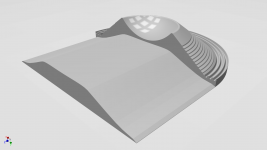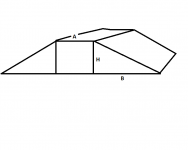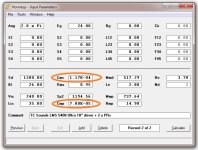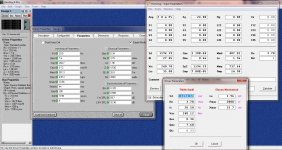You plot the gap yet?
Brian is smoke coming out of your ears from all this heavy thinking?
Hey, the lightbulb has turned on, and when it's on, it's usually difficult to turn it back off 🙂
It's like when I had the first idea to use a spreadsheet to map and fold a horn, showing the path and calculating the path length in the process. Two days of no sleep later...
I don't really need another subwoofer in the house, but passing up the opportunity to try something "new" (I can't remember coming across any BP designs specifically designed to treat the out of band noise via driver location in the cabinet), that's difficult to resist...
Hey, the lightbulb has turned on, and when it's on, it's usually difficult to turn it back off 🙂
It's like when I had the first idea to use a spreadsheet to map and fold a horn, showing the path and calculating the path length in the process. Two days of no sleep later...
I don't really need another subwoofer in the house, but passing up the opportunity to try something "new" (I can't remember coming across any BP designs specifically designed to treat the out of band noise via driver location in the cabinet), that's difficult to resist...
I know that feeling, and since your light is on and mine is not I have an idea 😀
David has a cone volume calculator but we don't have a tool that converts the volume to area in the expansion along the path length, I slice them manually in CAD and divide by the cabinet width so I can get the expansion correct, but I wonder if it's possible to do in excel?
Attachments
You plot the gap yet?
What do you think is making all the smoke in the first place!
What I know is that the normal travel of this is pretty symmetric, the first 3 to 4mm of plus or minus travel. The forward movement begins to be a little under powered near 8mm one way forward. Really happy going backwards. At 12mm one way forward there is a 35% drop in the B and I'm running into limitations in the surround and spider. Rearward, all happy to be in the flux. Welcome to making design compromises. I generally think about the first 5 to 6mm where 90%+ people will be happy campers. I keep that as clean as a whistle. From thee we get a little bit more dirty. Sims tell me that even at 10mm one way I have a 3% distortion factor from the motor. I'll have to see what the spider and surround add in.
So as you guessed the BL is not perfectly symmetrical. Explanation above.
Hey, the lightbulb has turned on, and when it's on, it's usually difficult to turn it back off 🙂
It's like when I had the first idea to use a spreadsheet to map and fold a horn, showing the path and calculating the path length in the process. Two days of no sleep later...
I don't really need another subwoofer in the house, but passing up the opportunity to try something "new" (I can't remember coming across any BP designs specifically designed to treat the out of band noise via driver location in the cabinet), that's difficult to resist...
I think I belong to the same club Master Steele.
Wishing you success in your endeavor.
Gotta tease you just a little bit right!
David has a cone volume calculator but we don't have a tool that converts the volume to area in the expansion along the path length, I slice them manually in CAD and divide by the cabinet width so I can get the expansion correct, but I wonder if it's possible to do in excel?
Don't start me thinking about tha...
Aw crap, now I'm thinking about it...
Don't start me thinking about tha...
Aw crap, now I'm thinking about it...
...and the answer turned out to be super-easy.
I'll describe it tomorrow - time for some shut-eye 🙂
the BP4 option doesn't seem to provide a means of exporting the predicted frequency response as an FRD file.
The feature will be added in the next update (for all the band pass systems).
Brian do you know of any good PR modeling software? I am about to build a big PR sub but most software seems to favor the traditional ported / sealed cabinets.
I have read that PRs are more like ported but not exactly the same.
Did you try VirtuixCAD?
...and the answer turned out to be super-easy.
I'll describe it tomorrow - time for some shut-eye 🙂
Given
V = Cone volume
R1= Cone radius
R2 = dust cap radius
W = internal cabinet width
H = V/(W*R1)
A=2*R2
B=R1-R2
Attachments
Given
V = Cone volume
R1= Cone radius
R2 = dust cap radius
W = internal cabinet width
H = V/(W*R1)
A=2*R2
B=R1-R2
Wow, that is simple, I wonder how close it gets? I've attached some sample data.
Attachments
Wow, that is simple, I wonder how close it gets? I've attached some sample data.
If the value of V is the calculated value from the Hornresp cone volume calculation utility, it should be pretty much exact.
Is there a way to turn off the auto correct in Hornresp, or do you just have to use the wrong parameters to calculate your box?
I am entering the TS parameters the manufacturers provided, and I have double checked them in BassBox Pro 6, but Hornresp keeps changing them to the wrong values.
I'm stumped what does everyone else do when you can't enter the right information?
I am entering the TS parameters the manufacturers provided, and I have double checked them in BassBox Pro 6, but Hornresp keeps changing them to the wrong values.
I'm stumped what does everyone else do when you can't enter the right information?
Attachments
Wow, that is simple, I wonder how close it gets? I've attached some sample data.
Been thinking about writing a program to calculate this, but wouldn't it depend on the thickness of the front baffle, and if the driver is flush mounted or recessed?
Still doesn't factor in the magnet, frame or spider, but those could be roughly approximated with a bit of math.
Is there a way to turn off the auto correct in Hornresp, or do you just have to use the wrong parameters to calculate your box?
I am entering the TS parameters the manufacturers provided, and I have double checked them in BassBox Pro 6, but Hornresp keeps changing them to the wrong values.
I'm stumped what does everyone else do when you can't enter the right information?
OK if you want to enter in the T/S parameters directly you double click on the Sd field and there will be a table to fill out. Don't worry about there being slight differences between what you see and what Hornresp calculates for a few of the numbers. There is a bit of difference in the way the numbers are manipulated between programs.
As an example the Mmd or total moving mass is calculated without the air load on it. Some programs do the opposite.
In short the math in Hornresp is solid. Myself and many other people have used Hornresp for professional design work for years. I calculates things as well as some very expensive programs. And is more versatile than just about any other program I have ever worked with.
Also Hornresp calculates acoustical power at a distance of one meter not SPL at one meter. Some programs differ. But there are ways to reconcile the differences.
Sound power level SWL and sound pressure level SPL distance compare acoustic power sound source noise Conversion of sound pressure to sound intensity conversion sound level energy level strength directivity factor coefficient sound intensity SIL - se
Last edited:
I am entering the TS parameters the manufacturers provided, and I have double checked them in BassBox Pro 6, but Hornresp keeps changing them to the wrong values.
If the BassBox Thiele-Small parameter values shown in your example are entered into Hornresp, all values remain the same except for Vas, which changes from 240.7 litres in BassBox to 240.28 litres in Hornresp. The difference is 0.17 percent, which has no material effect on the results.
The very small discrepancy is due to rounding errors introduced when Hornresp converts the entered Thiele-Small parameter values to their electro-mechanical equivalents for use in the simulation models. The electro-mechanical parameter values are converted back to Thiele-Small values when displayed in the Driver Parameters input form.
Xmax is rounded to one decimal place when entered into Hornresp, so the BassBox value of 33.66 mm becomes 33.7 mm, a difference of 0.04 mm, which is not significant.
The Sd values should always be the same - you must have entered a slightly different value in Hornresp to that shown in BassBox.
Just worked out these are real numbers, not some system generated error.
1.17E-04 is 0.000117 expressed in scientific notation. It is the same as 1.17 x 10^-4 or 1.17 / 10000.
Scientific notation is mainly used by physicists and engineers, to express very large or very small values in a more convenient form.
As an example the Mmd or total moving mass
Just to clarify, the total moving mass is given by Mms.
Mms = Mmd + air load
Where Mmd is the dynamic mechanical mass of the driver diaphragm and voice coil.
Just to clarify, the total moving mass is given by Mms.
Mms = Mmd + air load
Where Mmd is the dynamic mechanical mass of the driver diaphragm and voice coil.
Yep. Long day today.
- Home
- Loudspeakers
- Subwoofers
- Hornresp



